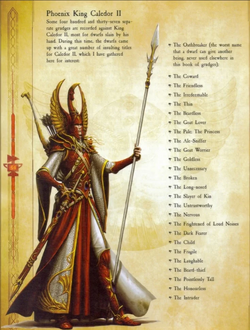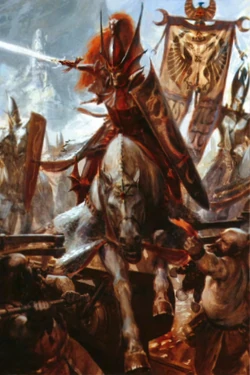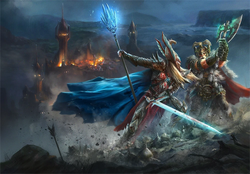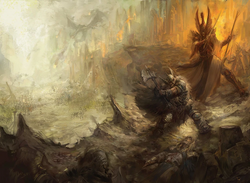"If we are beaten here, if we do as your mother and those like her want, it will kill the pride of Ulthuan. We will lose our sense of purpose. No, we won’t lose them. They will still be there, the ambition of empire and the pride of accomplishment. But it will forever be tainted by the poison of doubt. We’ll never again be certain of our path, so sure about our purpose. Always in the back of our minds, in the depths of our souls will be that little voice reminding us that the dwarfs forced us from these lands. Like a cancer, it will bleed the strength from our people. I won’t be the one to leave such poison behind. I won’t have that be my legacy. I won’t have my rule be a mockery of what came before. I am the son of King Caledor and I am worthy of that name. In my heart pumps the same blood as that of the Conqueror, the king who drove Malekith and his cursed followers from Ulthuan. I am the Phoenix King!"
- —Caledor II[9e]
Caledor II, called "Caledor the Warrior," born Tythanir[7a] or Menlaeth[8a][Note 1] depending on the source, was the fourth High Elven Phoenix King of Ulthuan and the son of the revered Caledor I. He was considered arrogant and impulsive but a great warrior, and was the Phoenix King who fought in the War of the Beard with the Dwarfs that brought to an end the period of amity between the two Elder Races.
Caledor II was slain in personal combat with High King Gotrek Starbreaker, who seized the High Elf monarch's Phoenix Crown as a trophy and returned it to Karaz-a-Karak, where it still remains to this day.[5b]
The poor judgement of Caledor II would lead the Asur to eliminate the idea of hereditary succession for the kingship of Ulthuan after his untimely death.[5a]
History[]
Age of the Conqueror[]
The children of Caledor the Conqueror grew up with a distant father who was more concerned with waging war and defeating his enemies than his family.[8c] His firstborn, who would later take on his name, had inherited his skills as a warrior. Caledor I had pushed his son to carry on his legacy, yet never regarded anything his firstborn did as fitting.[9e]
The future Caledor II was always jealous of his younger brother, Imladrik, who inherited the gift of Dragon-singing and was honoured by the Dragons of Ulthuan as well as the common folk alike. [7a] There was no bad blood between them, for Imladrik loved his brother, believed the crown to be his by right and did not envy him for having to live up to the memory of a father who had saved Ulthuan.[8a]
According to Liandra Athinol, the younger Caledor was ashamed that his father had refused to draw the Widowmaker to end the civil war against Malekith during the Sundering and sought to atone in his own way for what he saw as his father's weakness.[8e]
Unlike most Caledorians, Caledor II held a deep mistrust of Dragons, seeing them as beasts rather than allies.[7a] He also believed their time to be over and that it was a wasted life trying to coax them from their lairs when one could instead turn to aid their own kind.[8c]
Age of the Warrior[]

Because of his actions that led up to and during the War of the Beard between the High Elves and the Dwarfs, Caledor II is not considered to be among the greatest of the Phoenix Kings by the Asur.
After Caledor the Conqueror had perished, the Council of Princes that would choose his successor was held at the Shrine of Asuryan. Seeking continuity, the princes chose Caledor I's oldest son, who took the name Caledor II in honour of his father and great-grandfather. While he shared not his fathers' gifts, many Asur had still wished for a familiar hand on the tiller. [2a][5a] As a ruler, Caledor II sought to emulate and surpass his father's deeds, throwing himself into battle and neglecting all else but war.[8c]
When his brother Imladrik brought him news from the Elthin Arvan that High Elves had apparently attacked Dwarf caravans, Caledor II had been hunting in Chrace. Dismissing the unrest in the High Elven colonies of the Old World, his intent was instead to focus on the raids of the Dark Elves upon Ulthuan and instead leave the leaders of the colonies to fend for themselves. Imladrik was to lead the war against the Naggarothi instead.[7a]
The Shaving[]
In the aftermath of the assassination of the Dwarf Runelord Agrin Fireheart of Barak Varr, the High King of the Dwarfs Gotrek Starbreaker sent Forek Grimbok, his chief reckoner, to Ulthuan. Tension had risen between the High Elves and the Dwarfs over the years, and it was hoped that the alliance between the two Elder Races could perhaps be saved.[7b] In IV, 201,[2c] Caledor II confronted the Dwarfs with the fact that, in the two weeks it had taken the ambassador to come to his court, the first High Elven city in the Old World, Kor Vanaeth, had been razed by the hand of Prince Snorri Halfhand, the high king's son and heir.[7b]
The Dwarfs stated that they knew nothing of this and made their terms, demanding recompense and an apology for the grievances against their people, and demanded that all further violence should cease. Caledor II replied that he did not answer to demands, but instead granted pleas, especially since the high king was apparently unable to control his own subjects.[7b] Caledor II gave the order to seize the group, yet the Dwarfs resisted and one of their number was slain.[1a]
Against the protest of Imladrik, who knew what this deed would unleash between the Elves and Dwarfs, Caledor II issued the command to shave the Dwarf ambassadors' beards, a deadly insult among the Dawi.[7b] The Phoenix King sent them back to the Karaz Ankor with the message that if the high king wanted compensation, he should come to Ulthuan to collect it in person.[1a]
High Elf historiography tells a different tale of how the conflict began. In this version, it was the Dwarfs that provoked the conflict instead when the Dwarf ambassador arrived at Caledor II's court. Swearing upon his beard that he would not leave until justice was served, the ambassador drew a weapon in front of the king to demand recompense. While normally such an act would be a capital crime in the court of the Phoenix King, Caledor was merciful and, condemning the ambassador by his own words, shaved the Dwarf's beard and sent him back to the Old World.[3a] Yet among the contemporaries of the Phoenix King, all but the most blinkered of his ministers regarded the shaming of the Dwarf ambassadors as foolish.[8d]
War of the Beard[]
"So much for this War of the Beard! The stunted ones dared to challenge their betters and thus have been bloodied. They will think twice before assaulting our colonies again. Should they now sue for peace and come before me on their knees, we shall be magnanimous. But if they dare, if they dare, to rise up against us again, we shall visit vengeance on them a thousandfold. We shall root them out of their holes and drag them into the sun light. We shall burn their mines and flood their holds. We shall seize their goods and make prisoners of their wives – though what use one might have for such creatures, I have little idea."
In IV, 224,[2c] Caledor II set sail to aid his people in person and to take what he believed would soon be the Dwarfs' plea of surrender. At the field of Angaz Baragdum, the Phoenix King engaged the army of Prince Snorri Halfhand. The two nobles of the Elder Races decided to resolve the conflict with a duel. In secret, Caledor II gave the order to his chancellor Hulviar to attack after the duel to send a message to the high king. Despite his skill, Snorri was hopelessly outclassed by the Phoenix King, who killed the Dwarf prince with little effort. Afterwards, Caledor took Snorri's mangled hand as a trophy and returned to Ulthuan to enjoy the hunting season.[7c]
The Asur again tell a different story about the Dwarf prince's death and claim that Caledor II, ever merciful, declared that no Dwarf should be harmed lest they harmed an Elf, but the Dwarfs' hatred of those they now named the "Ugly Folk" drove them on, forcing the Asur to defend themselves. Seeking to end the bloodshed, Caledor II sought to parley with Prince Snorri, yet the Dwarf was arrogant and brash and attacked him. Despite begging him to see reason, the Phoenix King had no choice but to kill his opponent.[3a] He even allowed Snorri to rise when knocked to the ground and delivered a clean killing blow.[11a]
After his return in IV, 230, Caledor II presented the hand of Snorri Halfhand to an adoring crowd of High Elves in Lothern, promising that Malekith was nearly beaten and the Dwarfs had been defeated. To commemorate this day, the Phoenix KIng declared the day of his defeat of the Dwarf prince a holiday, the Day of Severing.[8b]
In order to meet again with his brother, Caledor II travelled to Kor Evril. He ordered Imladrik back to Elthin Arvan, the Old World, incited by his chancellor, who warned Caledor that the conspiracies of the High Elven nobles might make Imladrik a figurehead for their own desires for the throne. While the loyalty of Imladrik to his brother was never in doubt, Caledor knew of his brother's lack of interest in politics and feared that in his naivete Imladrik might be turned against him. Imladrik pleaded to continue the campaign against the Druchii, yet Caledor II remained steadfast in his decision.[8c]
Imladrik died in Elthin Arvan in that same year,[2c] while attempting to defend his own city Oeragor from the Dwarfs. His Dragon, Draukhain, carried his body back to Tor Alessi.[8f] While publically untouched, the Phoenix King was deeply shocked by the death of his younger brother, and wore the white colour of mourning when in private, while questioning the line of reasoning that had led to his fateful orders. With the realisation that with the death of his brother and his lack of children he had no heirs, Caledor II decided to take Thoriol, the son of Imladrik, to his court at Lothern to groom him as his successor.[9a]
In order to keep his best generals focused on Naggaroth, Caledor II sent many aspiring but less experienced and skilled High Elf generals to the Old World colonies, only for them to suffer defeat there by the Dwarfs, disgrace at court and replacement by the next ambitious noble. This practice fanned the flames of resentment of the nobility against the policies of the Phoenix King, with many of his supporters turning from him.[9d]
It did not help matters that the war in the Old World went poorly. The fortress cities of the Dwarfs were virtually impregnable. The dour, stalwart Dwarf troops were quite unlike any foe the High Elves had faced before. Displaying the tenacity and stubbornness for which they were later renowned, the Dwarfs simply refused to give up or admit defeat, even when hopelessly outnumbered. For their part, the Dwarfs were astonished by the power of the High Elf forces. They had mistakenly judged the strength of Ulthuan by that of the least of its provinces. The huge armies of High Elven knights and disciplined infantry were not what they had expected of a people they had considered effete weaklings. Still, in true Dwarf fashion, they were not about to admit to a mistake, especially to an Elf.[1a]
The war dragged on, with Ulthuan being bled white while attempting to fund war efforts in both Naggaroth and Elthin Arvan. Believing that Malekith was no longer as grave a threat to Ulthuan as before, Caledor II committed more and more of his forces to the war against the Dwarfs.[9b] As the Dragons began to retreat from the war, the situation became more and more precarious for the High Elves. Upon his request, Caledor II sent his nephew and heir Thoriol to Tor Alessi as his emissary to rekindle the hopes of the High Elf colonists.[9c]
When Thoriol was wounded in defence of the city, Caledor II decided to not lose another family member and marshalled the full force of Ulthuan to finally bring the war against the Dwarfs to an end, against the wishes of the Council of Princes who instead wished to ensure the demise of the Witch King. To appease them, Caledor II installed Caradryel of Yvresse as his steward in order to keep the throne safe for his intended heir.[9d]
Fourteenth Siege of Tor Alessi[]

Caledor II charging a Dwarf unit during the War of the Beard.
In IV, 596,[2c] Caledor II made landfall in Tor Alessi, hoping to end the war in a single, brutal show of force to force the Dwarfs to submit.[9e] High King Gotrek Starbreaker offered Caledor a way to end the war by paying a ransom, knowing full well that the sheer arrogance of the Phoenix King would never allow him to accept. Enraged at the offer, Caledor instead decided to crush the Dwarfs once and for all. Splitting his armies between himself and Prince Thoriol, Caledor II decided he would hold the city of Tor Alessi while Thoriol led an assault, the High Elf Navy ships sailing amidst the refugee barges that were destined for Sith Remora. These forces would use the refugee fleet as a screen to make landfall and assault the Dwarf host from behind.[9f]
Yet the armies of Gotrek Starbreaker managed to penetrate the High Elf city beforehand, leaving Caledor II to lead the battle from within the city. Leading his Silver Helms, the Phoenix King wreaked untold carnage among the Dwarfs until he was cornered. Then, High King Gotrek issued his challenge. If Caledor killed him in a duel, there would be no further grudge and the Dwarfs would let the High Elves go. The Phoenix King accepted, never even imagining the possibility of defeat, and the two kings clashed.[9f]
They proved evenly matched, the High King of the Dwarfs driven by hatred and vengeance, the Phoenix King by pride and scorn. When Gotrek managed to bring Caledor II down, the Phoenix King pleaded that he would pay the wergild, yet the Dawi king showed no mercy and buried his axe in the stiff neck of the High Elf monarch.[9f]
The High Elves once again tell a different story. Their histories claim that, during the final days of the war, Caledor II, weary of fighting, opened the gates of Tor Alessi to High King Gotrek Starbreaker in order to find a way to end the conflict. The treacherous Dwarf accepted and, once in the city, bade his retinue to kill the sleeping warriors of the Asur.[3b]
Gotrek Starbreaker himself planned to murder the Phoenix King in his sleep, yet Caledor had been alerted. The two kings fought, with Caledor's strike being tempered by his desire for peace. Yet the Dwarf ruler, lost in vengeance, cut him down and stole his crown. Afterwards, the ally of the Dwarfs, the Witch King Malekith, led his armies against Ulthuan, preventing the Asur from retaking the crown of the Phoenix King.[3b]
Legacy[]

Phoenix King Caledor II faces the High King of the Karaz Ankor amidst the ruins of Tor Alessi.
Caledor II is still remembered as one of the most despicable of Elves by the Dwarfs, as four hundred and thirty-seven grudges against Caledor II are still recorded in the Dawi's Great Book of Grudges.[6a] The fact that the Phoenix Crown still remains in Karaz-a-Karak has caused many Asur to denounce the Dwarfs as thieves.[5b]
Due to the High Elves' experiences during the reign of Caledor II, the Asur forvever after abandoned the idea of a hereditary kingship, and the Phoenix King would instead be the candidate elected by the Council of Princes that they judged to be the best fit for the throne of Ulthuan, regardless of his blood relation to a prior monarch.[5a]
Wargear[]

Phoenix King Caledor II faces High King Gotrek Starbreaker in their final duel that brought an end to the War of the Beard with Caledor II's death.
Caledor II's personal banner was pale blue,[8c] with his heraldry showing a dragon and a phoenix, wings and talons wide spread.[9e]
- Phoenix Crown - Worn by all Phoenix Kings since Aenarion, Caledor II was the only one to wear it to battle.[9f] After his death, the artefact was taken by the Dwarfs and remains to this day in Karaz-a-Karak.[1a]
- Torment - Torment was the Elven Steed of Caledor II, sired by one of the few remaining stallions of the royal herd of Tiranoc.[9f]
- Dawnkiller - Forged by Caledor Dragontamer to spill the essence of Greater Daemons, this was the High Elf sword Caledor II chose to carry during the Fourteenth Siege of Tor Alessi where he met his fate.[9f]
- Skin of Vaul - The Skin of Vaul was the Phoenix King's golden breastplate, said to have been forged in the fires of the gods themselves. [9f]
- The Dragonshard - The Phoenix King's warhelm, forged around a scale taken from Indraugnir, the Dragon mount of the first Phoenix King, Aenarion.[9f]
- Lathrain - Literally meaning "Wrathbringer" in Reikspiel, Lathrain was the blade once wielded by Caledor II's revered father, Caledor I.[8g]
Canon Conflict[]
- Note 1: In the novel Caledor: Tales of The Sundering (2011), Caledor II's birth name was implied to be Tythanir. Tythanir shows many of the same character traits as Caledor II, including arrogance, petulance, and entitlement. As Tythanir is implied to be Imrik's first child, it was generally accepted that Tythanir is a young Caledor II.[7a] However, in the novel Master of Dragons (2013), part of the War of Vengeance trilogy, Caledor II's birth name is referred to as Menlaeth, not Tythanir.[8a]
Sources[]
- 1 Warhammer Armies: High Elves (8th Edition)
- 1a pg. 20
- 2 Warhammer Armies: High Elves (7th Edition)
- 3 Warhammer Armies: High Elves (6th Edition)
- 4 Warhammer Armies: High Elves (5th Edition)
- 5 Warhammer Armies: High Elves (4th Edition)
- 6: Warhammer: Grudgelore (Background Book)
- 6a: pg. 46
- 7 The Great Betrayal (Novel) by Nick kyme
- 8 Master of Dragons (Novel) by Chris Wraight
- 9 Curse of the Phoenix Crown (Novel) by C.L. Werner
- 10 Caledor (Novel) by Gav Thorpe
- 10a Ch. 2
- 11 White Dwarf #265 (UK Edition)
- 11a pg. 83
